2023.08.01.83
Files > Volume 8 > Vol 8 No 1 2023
Effect of seeds, oil, and black seed meal on Japanese Quail's productive performance
Yaser Ghanim Kesab1,*, Mohammed Mahmood Khaleel2 , and Raghad Naseer AL-Flayyih3
1 Department of Animal Production, College of Agriculture and Forestry, University of Mosul, Mosul, Iraq
2 Department of Animal Production, College of Agriculture and Forestry, University of Mosul, Mosul, Iraq
3 Department of Animal Production, College of Agriculture and Forestry, University of Mosul, Mosul, Iraq
* Correspondence: Email: [email protected]
Available from: http://dx.doi.org/10.21931/RB/2023.08.01.83
ABSTRACT
The research aims to effect using seeds, oil and black seeds meal on the productive performance of Japanese Quail. Seven experimental diets were used in the study; T1 was the control (with 0% seeds, oil or black seed meal), and T2 and T3 contained black seeds (BC) at two levels, 0.80 and 1.60%, respectively. T4 and T5 black seed oil (BSO) was added at 0.50 and 1% levels, respectively, while the last two treatments, T6 and T7, contained black seed meal (BSM) at two levels of 7 and 14%, respectively. Mash feed and water were submitted ad libitum during the whole period. The study includes one stage; the growth period (1-35 days old). This research was conducted at a poultry farm, Animal Production Department, College of Agriculture and Forestry, University of Mosul, Mosul, Iraq. A total of 588 desert color Japanese quail (Coturnix coturnix japonica), unsexed at one day old, were randomly distributed in seven previous treatments of six replicates with 14 birds in each in the growth period. The results showed significant effect (p≤ 0.05) in body weight(g/bird),body weight gain(g/bird), Protein digestion coefficient(%), Preslaughter weight(g/bird), carcass weight(g/bird), for T3. While the data showed a significant effect (p≤ 0.05) for T2 in water intake. The data confirmed the superiority of the T3, T5 and T7 in carbohydrate digestion coefficient(%). The growth rate recorded a significant effect (p≤ 0.05) for T3, T4, T5 and T6. As well as, T3 reported a low significant effect (p≤ 0.05) on feed conversion ratio(g feed: g WG) and water conversion ratio(ml: g WG). The best net revenue(Iraqi Dinar: g WG ) was T7 and T3. No significant differences were founded in all other traits in this study.
Keys words: seeds, oil, black seeds meal-productive performance -Japanese Quail.
INTRODUCTION
The black seed plant (Nigella sativa L.) is a medicinal plant, and it is a member of the Ranunculaceae family1; this plant is generally known as the black seed or black cumin2. But it is called in Arabic Habbat ALbaraka or ALhabba ALsaodaa3,4, and the origin of this plant is in Iraq, Saudi Arabia, Syria, Turkey and Pakistan5. The seeds have many active compounds such as Nigellin, carvene, Thymoquinone and Thymohydroquinone6. These seeds also contain metabolizable energy of more than 4949 Kcal. /Kg, and also have a high percentage of ether extract, about 36.94 % and crude protein, 23.27 %. (in this study), As well as black seed oil includes a high percentage of unsaturated oil as linoleic acid, above 60 %7. Black seed meal also contains high levels of metabolizable energy 3186 Kcal / Kg and crude protein, about 37.94 %. (in this study) But black seeds meal contains a high level of crude fiber, more than 12.15 %. So that black seeds, black seed oil and black seeds meal are used in poultry nutrition. Therefore, the seeds, oil and meal of the black seed are used to increase the immunity of birds, improve the productive performance of growth characteristics, improve feed conversion efficiency, blood and carcass characteristics, and even economic calculations8-16. This study aims to use all these matters together in one research and to know the effect of Japanese Quail on some productive performance traits.
MATERIAL AND METHODS
The aim of this research is to study the effect of using seeds, oil and black seeds meal on the productive performance of Japanese Quail (Coturnix coturnix japonica). Seven experimental diets were used in the study; T1 was the control (with 0% seeds, oil or black seed meal), and T3 contained black seeds (BC) at two levels, 0.80 and 1.60%, respectively, T4 and T5 black seed oil (BSO) was added at two levels of 0.50 and 1% respectively, while last two treatments were T6 and T7 contained black seed meal (BSM) at two groups of 7 and 14% respectively. Mash feed and water were submitted ad libitum during the whole period. This study was in a single phase lasting 1-35 days. This research was conducted at a poultry farm, Animal Production Department, College of Agriculture and Forestry, University of Mosul, Mosul, Iraq. A total of 588 desert color Japanese quail (Coturnix coturnix japonica), unsexed at one day old age, were randomly distributed in 7 previous treatments of 6 replicates with 14 birds each in the growth period. The birds were housed in an iron cage 50 × 50 × 50 cm with the same condition and rearing. The rations contain about 2911-2916 kcal/kg metabolizable energy and 24.09 -24.12 % crude protein. The Nutrient requirements of growing Quail and the chemical composition of the last diets in the research were according to 17, table 1. The seeds of black seed were obtained from the local market of the city of Mosul in Iraq, while the oil and black seed meal was obtained from one of the factories of medicinal plant oils in the city of Mosul. The oil was obtained from the seeds by pressing a homemade press, and the rest of these seeds are the expeller black seed meal, table 2. The birds were weighed every week; then the weight gain was extracted, while the relative growth rate was calculated as found by 18, and deaths were recorded daily, and then their percentage was calculated at the end of the study, the consumed feed was calculated through the difference between the feed added and the remaining feed, as well as the efficiency of feed conversion (gm of feed: gm of weight gain). And according to the water consumption and Water conversion ratio according to 19 as follows: Water consumption(ml/bird) = water added (ml/bird) - water remaining (ml/bird), Water conversion ratio(ml: gm) = water consumption(ml/bird)/weight gain (gm/bird).
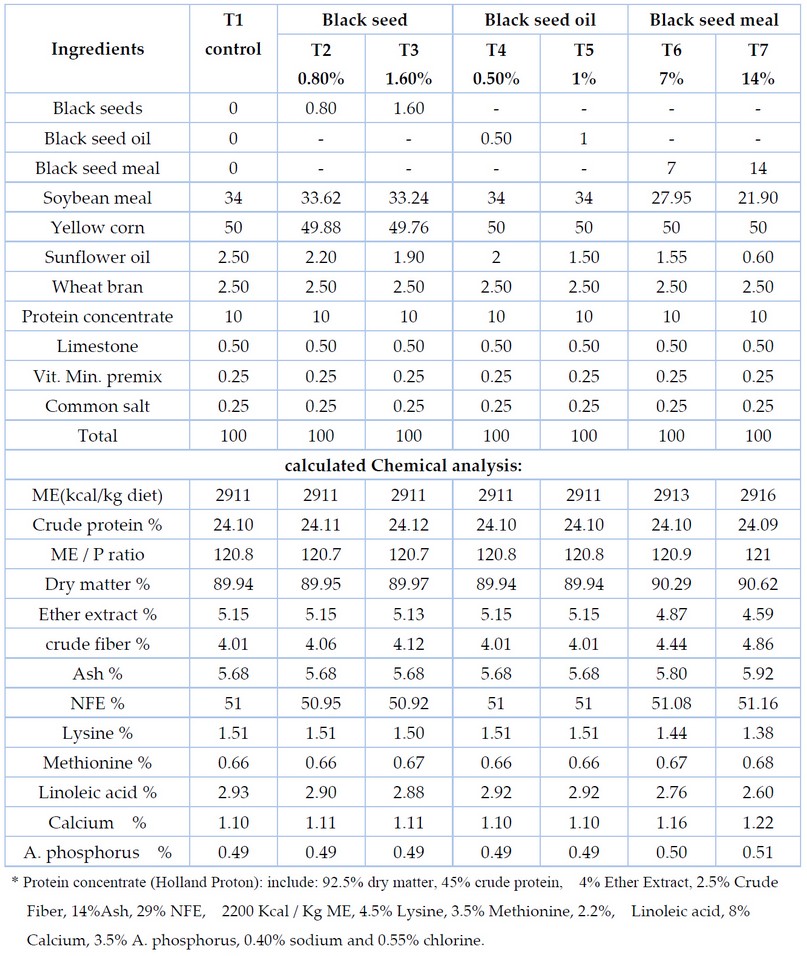
Table 1. The components of the research as well as the chemical analysis calculated in 1-35 days
A digestion experiment was conducted to calculate the digestibility factors of dry matter, crude protein, crude fiber, crude fat and soluble carbohydrates. At the age of 35 days (end of the study), the birds were cut off feed for 6 hours before slaughter; these birds were weighed. Twenty-four birds from each treatment were slaughtered, with 12 males and 12 females from each treatment, after which the characteristics of the carcass were recorded as stated in 20. Sensory evaluation (Tenderness, juiciness, flavor and Acceptability) of a piece of Japanese quail breast was conducted by grilling the breast meat in an electric oven at 177°C. When the internal temperature of the meat pieces reached 80°C, then the evaluation forms were submitted to arbitrators, according to the method21. The economic variables were calculated during the period (1-35) days to produce 1 kg of live weight, as approved by 19. The statistical program SAS 22 by using the computer, was used to analyze the data statistically for a simple experiment with one factor. It was applied by complete random design (CRD) for the significance of the differences between means, tested by Duncan's multiple range test, while the value of the standard error of these means was found.
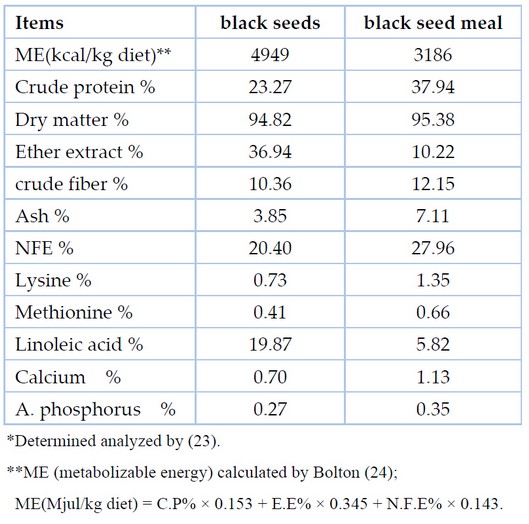
Table 2. Laboratory analysis of black seed and black seed meal in research
RESULTS
The results in Table 3 indicate the superiority of treatment 3 (1.60% black seed) significantly (P ≤ 0.05) in the traits of body weight(BW) and body weight gain(BWG); the reason may be due to The herb's useful for reducing microbial aggregations and decreasing amino acid hydrolysis, thus, an improvement in weight gain can be seen due to the increased availability of amino acids. 25.
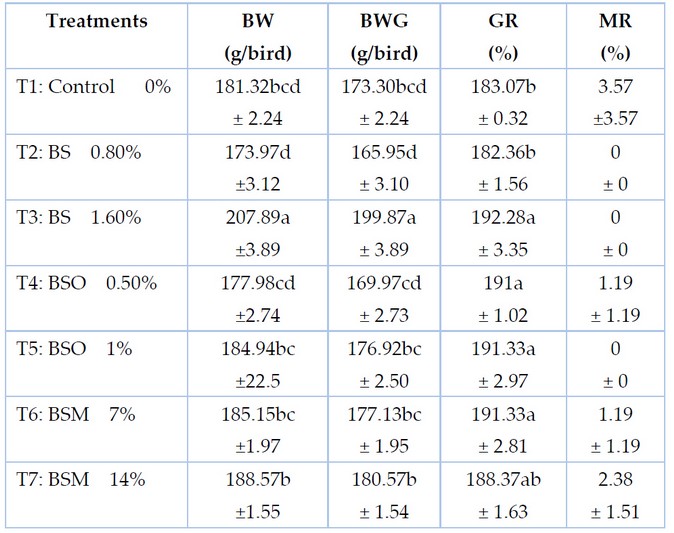
Table 3. Effect of using seeds, oil and black seed meal on body weight, weight gain, growth rate and mortality rate in this study 1-35 days
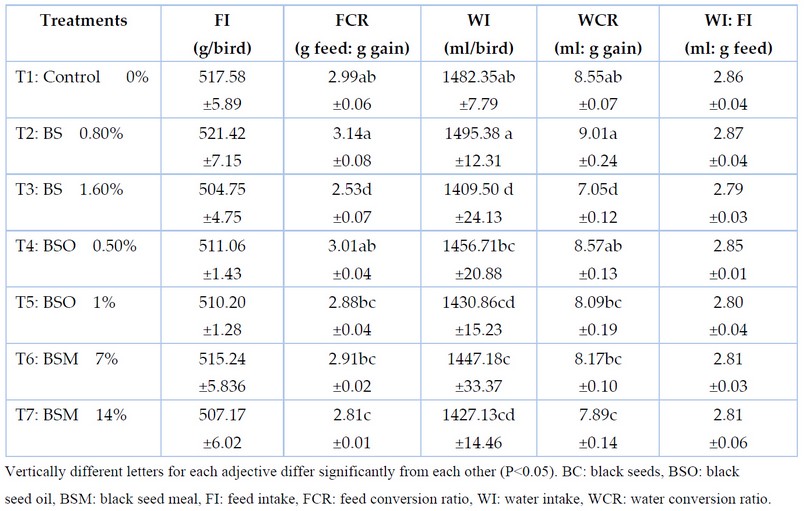
Table 4. Effect of treatments on some feed and water traits 1-35 days
The results of Table 5 indicate a significant superiority (P ≤ 0.05) of treatment 3 in the digestion coefficient of crude protein and treatments 3, 5 and 7 in the coefficient of digestibility of soluble carbohydrates.
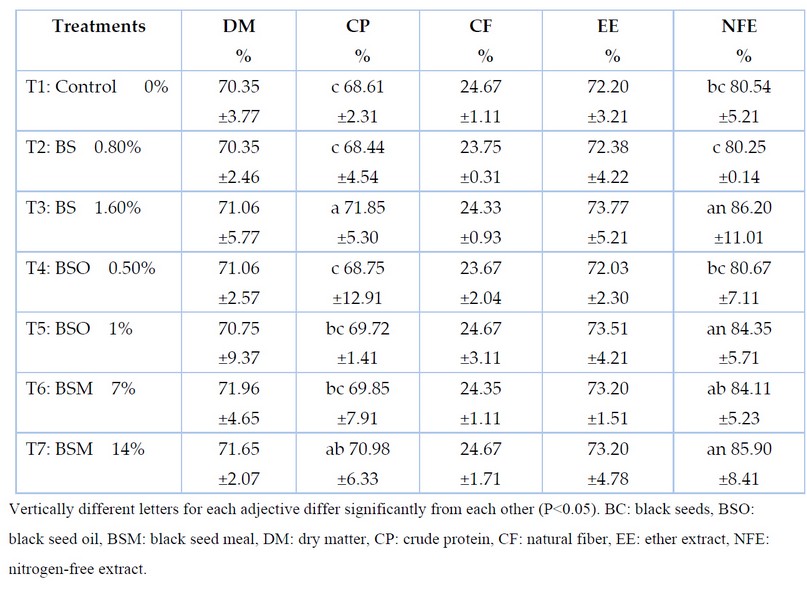
Table 5. Treatments effect In the digestion coefficients of some feed compounds for the diets at 1-35 days
The results of table 6 show that there are no significant differences (P ≤ 0.05) for all biochemical blood traits, but these results confirmed that treatment 3 had the highest rate in total protein, albumin and globulin, and treatments 4, 3 and 2 had the highest rates in total cholesterol, HDL cholesterol, and LDL cholesterol, respectively.
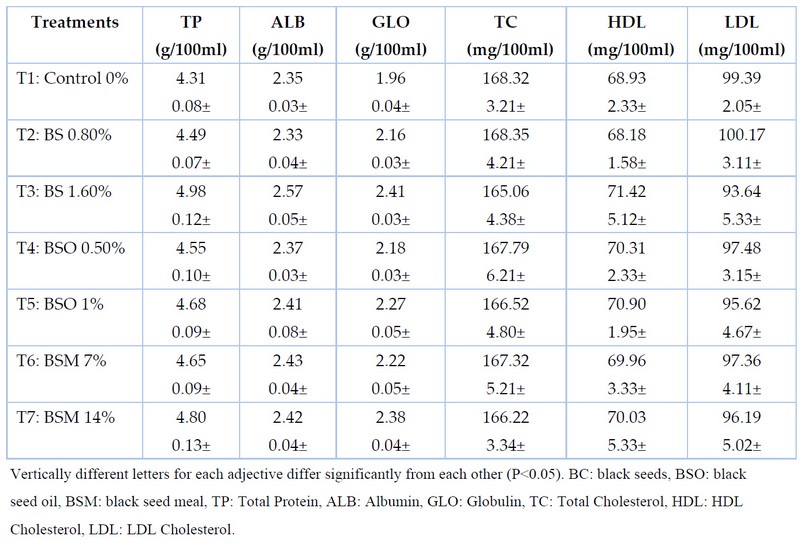
Table 6. Effect of treatments In some biochemical blood traits at 35 days
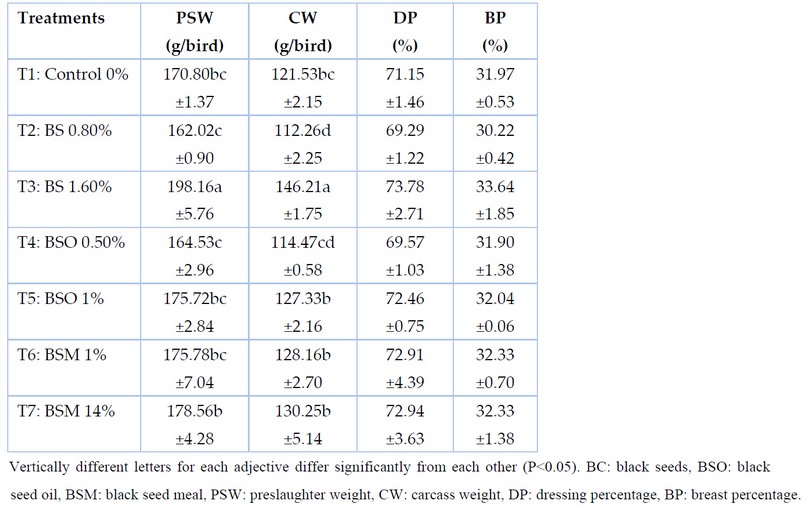
Table 7. Treatments affect some carcass traits at 35 days
Table 9 presents the results of economic feasibility for the production of 1 kg of body weight for the period from 1 to 35 days; it is noticed from this table that the value of the intake feed costs decreased when adding 1.6% of the black seeds 26 and 30, as well as adding 7 or 14% of the black seed meal 4, and 31. As for the other costs, they decrease with all the additions 4 and 31. While the value of the total costs return to lower in the same order as the value of the intake feed costs 4, 30,31. Concerning revenue, its value is the selling price of 1 kg of the live body weight of the bird, which is 9000 Iraqi dinars(ID) for all treatments 4,15, and 31. The best net revenue value and best % net revenue: Total costs for the transaction were for treatment 3, treatment 7, and treatment 6.
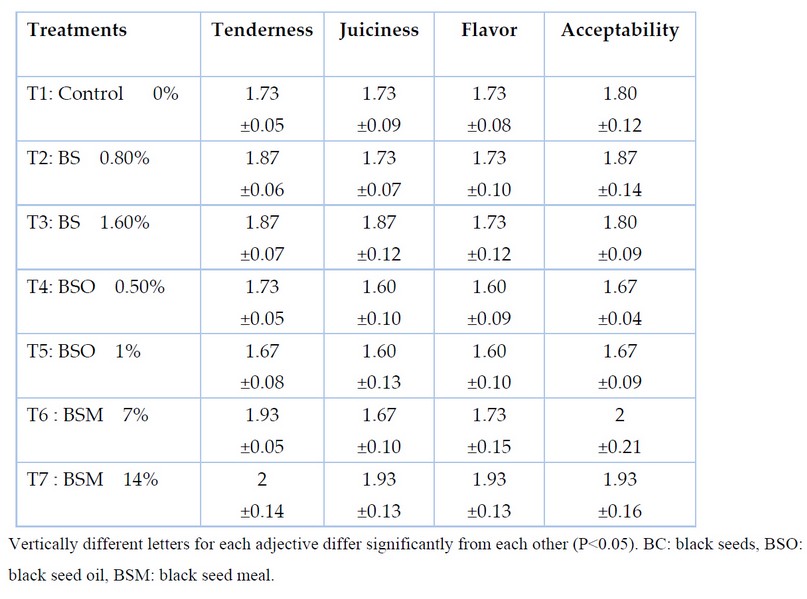
Table 8. Effect of treatments on some sensory meat taste at 35 days
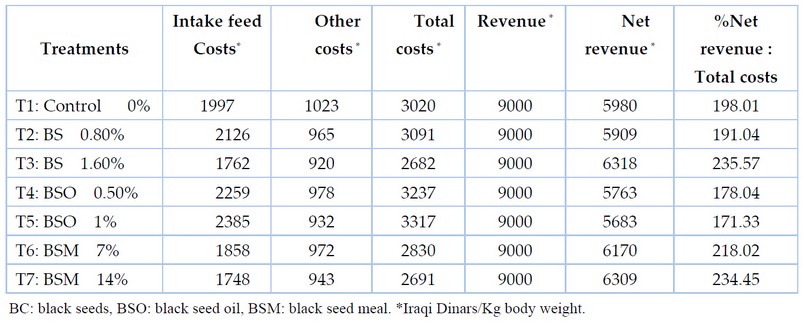
Table 9. Treatments effect on some economic feasibility (Iraqi Dinar/kg BW) 1-35 days
DISCUSSION
The results of these two traits, body weight(BW) and body weight gain(BWG), were similar to the results of 25 When feeding a growing Japanese quail with black seeds, 26, 27 and 28 When they used broilers in their studies. At the same time, the results of this study differed with 8, 29, 30 and 13; they fed broilers with different percentages of black seeds. As for the moral superiority (P ≤ 0.05) of quail birds in the growth rate(GR) characteristic, it went to treatment 3(1.60% black seed) than treatments 4, 5(0.50 and 1% black seed oil) and 6(7% black seed meal), The reason of that growth rate is calculated using body weight at the beginning and end of the study period, meaning that it depends entirely on body weight, and this is a reflection of the result of body weight, these results agreed with 31. When the broiler was fed with the different pedigree of the black seed meal, While it is not similar with 4, by offering different percentages of black seed meal to two strains of broilers. Finally, in Table 3, there were no significant differences (P ≤ 0.05) in the mortality rate(MR) for all treatments. This result is in line with the results of 32, 30 and 33 After feeding broilers with different levels of black seeds and 34 Feed broilers with black seed oil. At the same time, this result did not agree with black seeds, 36,37 and 27 with black seed meal.
The significant decrease (P ≤ 0.05) indicated the superiority of treatment 3 in feed conversion ratio(FCR) g feed: e gain and water conversion ratio(WCR) ml: g gain, which is shown in Table 4, This may be the reason for this superiority in the first adjective(FCR) because the FCR is calculated by dividing the amount of feed intake by the body weight gain, and in this study, this treatment has the highest body weight gain with a scientific difference and has the lowest rate of feed intake with an arithmetic difference, while the reason of second adjective(WCR) may be because the WCR is calculated by dividing the amount of water intake by the body weight gain, and in this study, this treatment has the highest body weight gain with a scientific difference and has the lowest rate of water intake with a scientific difference, The results of FCR were similar with (38), 27 and. 28 but this results did not look like with 39 and 40. In the same table, Treatment 2 had the highest significant difference (P ≤ 0.05) in water intake(WI) between treatments; the reason for this difference may be because the birds consume an amount of water equivalent to approximately 2-3 times the amount of feed intake under normal conditions. The birds of this treatment consumed the highest amount of feed, but with arithmetical differences. No significant differences (P ≤ 0.05) were recorded for the other traits in this table; the result of feed intake was similar to 4,9, 14, 27, 29, 39, 40 and 41. However, it was not identical with 12, 15, 30 and 31. Whereas the reason for the superiority of the digestion coefficient of crude protein is that the increase in the rate of black seeds in the diet reduces the number of harmful bacteria in the intestines of birds 25 and 33, this leads to decreasing amino acid hydrolysis; thus, an improvement in weight gain can be seen due to the increased availability of amino acids 25, from the direction. Also, the increase in the percentage of black seeds leads to an increase in the concentration of total protein in the blood serum of these birds 11,12,15,16,30,32, 36,37,38 and,39. Thus it is constantly available to benefit from it to build tissues and cells of the body, and this indicates a good digestion coefficient of crude protein in the ratio. And the reason of the second adjective maybe back that increasing the percentage of black seeds reduces the concentration of glucose in the blood serum of the birds of these treatments 30,32 and 39, and this means the use of large amounts of glucose sugar in building cells and tissues of the body, which means an increase in the coefficient of digestion of dissolved carbohydrates, from the direction. What confirms this is a decrease in the concentration of total cholesterol and an increase in the concentration of HDL in the blood serum of the birds of these treatments 10,15, 32, and 38. The results of the protein digestion coefficient differed with 26 and 32. Total protein, albumin and globulin results were confirmed by 30 but not approved by 32. Total Cholesterol, HDL, and LDL results were also similar to 39 but not identical to 10. In table 7, Treatment 3 recorded a significant difference (P ≤ 0.05) in preslaughter weight(PSW) and carcass weight(CW); the reason for the superiority of this treatment in these two characteristics, it is the highest body weight and significant difference 20, Which showed that there is a direct relationship between body weight and carcass weight. Since treatment 3 had the highest final body weight with a significant difference, this was reflected in the preslaughter weight. The results of these two traits were not similar 30 and 36; the results of the other transactions in the table did not record significant differences.
While the results in Table 8 did not record significant differences (P ≤ 0.05) in sensory meat taste, the results confirm an arithmetic improvement for treatment 5 in tenderness and treatments 4 and 5 in juiciness, flavor and acceptability, not all of these results match results of 4.
CONCLUSION
The best feed addition from Black seed, Black seed oil and Black seed meal was T3 at 1.60 % Black seed because it has the best final body weight (g/bird); weight gain (g/bird), and feed conversion ratio (g feed: g weight gain). As well as best carcass weight (g/bird) and dressing percentage(%) . Finally this treatment has higher net revenue (Iraqi Dinar/Kg body weight).
Acknowledgment
The authors are very grateful to the University of Mosul / College of Agriculture and Forestry for their provided facilities, which helped improve this work's quality.
REFERENCES
1. Ahmad, Md. F., F. A. Ahmad, S. A. Ashraf, H. H. Saad, S.; Wahab, M. I. Khan, M. Ali, S. Mohan, K. R. Hakeem and Md. T. Athar. An updated knowledge of Black seed (Nigella sativa Linn.): Review of phytochemical constituents and pharmacological properties. Journal of Herbal Medicine. 2021, 25 : 1-11.
2. Mashayekhi-Sardoo, H., R. Rezaee and G. Karimi. Nigella sativa (black seed) safety: an overview. Asian Biomedicine. 2020, 14 (4) :127–137.
3. Farhan ,N .,N.Salih and J .Salimon. Physiochemical properties of Saudi Nigella sativa L. (Black cumin) seed oil. Oilseeds and fat Crops and Lipids. 2021, 28 (11) : 1-9.
4. Taha, N. T., Y. G. Kesab and I. M. Dahal. Effect of replacement different levels of black seed meal instead of soybean meal for two broiler strains on productive performance and carcass traits. Unpublished research, 2021.
5. Assi, M. A., M. H. Mohd Noor, N. F. Bachek, H. Ahmad, A. W. Haron, Md S. Mohd Yusoff and M. A. Rajion. The Various Effects of Nigella Sativa on Multiple Body Systems in Human and Animals. Pertanika Journal of Scholarly Research Reviews . 2016, 2(3): 1-19 .
6. Ashfaq, S., N. T. khan and G. M. Ali. (2021). Nigella Sativa (Kalonji), Its Essential Oils and Their Therapeutic Potential. Biomed J Sci & Tech Res. 33 (1) : 25448-25454.
7. Thilakarathna, RCN., GDMP Madhusankha and SB. Navaratne. Determination of composition of fatty acid profile of Ethiopian and Indian black cumin oil (Nigella sativa). International Journal of Food Science and Nutrition. 2018, 3(3); 1-3.
8. Attia, F. A.and M. A.AI-Harthi. Effects of dietary rosemary leaves and black seed on broiler performance. Egyptian Poultry Science Journal. 2018, 38 (2): 465-481.
9. Jahan, M. S., M. Khairunnesa, S. Afrin and M. S. Ali. Dietary black cumin (Nigella sativa) seed meal on growth and meat yield performance of broilers. SAARC Journal of Agriculture. 2015, 13 (2) : 151-160
10. Abd El-Hack, ME, M. Alagawany, M. Saeed, M. Arif, M.A. Arain, Z.A. Bhutto and S.A. Fazlani. Effect of gradual substitution of soyabean meal by Nigella sativa meal on growth performance, carcass traits and blood lipid profile of growing Japanese Quail. Journal of Animal and Feed Sciences. 2016, 25 : 244-249.
11. Ghaly, M. H., A. A. Elghoneimy, H. K. Mohamed and M. F. Ali. Biochemical and Histopathological Effects of Dietary Supplementation of Nigella sativa and Mentha piperita Oils to Broilers. Journal of Advanced Veterinary Research. 2017, 7 (1): 7-15.
12. Aziza, A. E., FM Abdelhamid, E. F. Risha, M. M. Elsayed and W.F. Awadin. Influence of Nigella sativa and rosemary oils on growth performance, biochemical, antioxidant and immunological parameters, and pathological changes in Japanese Quail challenged with Escherichia coli. Journal of Animal and Feed Sciences. 2019, 28 : 354–366.
13. Demirci, M., M.A. Karslı and Y. Aluç. Determining the effects of black cumin seed oil on performance and meat fatty acid profile of broiler chickens. South African Journal of Animal Science. 2019, 49 (5) : 890-897.
14. Rashid, SM. and R Aydin. Effects of black cumin oil (Nigella sativa L.) on fatty acid composition and cholesterol level of eggs in Japanese quails. EC Nutrition. 2019, 14(8) : 561-568.
15. El-kashef, M. M. A. Effect of different. levels of Nigella sativa n growth performance,some blood biochemical and immune-responsiveness of broiler chicks. Egyptian Poultry Science Journal. 2020, 40 (3) : 729-741
16. Adegbeye, M. J., O. D. Oloruntola, J. O. Oyeniran, S. O. Ayodele, G. Agboola and A. A. Oladipo. The growth, viability, and blood indices of broiler fed on papaya, black cumin, and mustard seed powder supplemented diets. Plant Archives. 2021, 20(2) : 7560-7566.
17. National Research Councill, Nutrient requirement of poultry. 9th ed. National academy press. Washington D,C., USA, 1994.
18. Brody, S. Bioemergetics and growth. Reinhold publ. Corp, New York. USA, 1949 .
19. Kesab, Y. G. S. (2021). Effect of replacement different levels of dried bread waste instead of yellow corn on some productive, carcass traits and meat sensory of broiler. (unpublished research).
20. AL-Fayadh, Hamdy A Saad A. Naji and Nadia N. A. AL-Hajo. Poultry product technology. Part two; Poultry meat technology. Second ed. University of Baghdad. Baghdad. Iraq, 2011.
21. Vessely, J. A. Fatty acids and steroid affecting flavor and aroma meat from ram crypt orchid and weather lambs. Journal of Animal Science. 1973, 53: 67
22. SAS. Statistical Analysis systems. Software, v.9, SAS Institute, Cary, NC.USA, 2002.
23. AOAC Association of Official Analytical Chemists, Official Methods of Analysis, 15th Edition, Washington, DC, USA. 1990.
24. Bolton, W. Poultry nutrition : Ministry of agriculture fisheries and food bull. No. 1974HMSO. London, 1967.
25. Emad H. H. Alsalmany , TH. T. Mohammed. Effect of adding natural zeolite and vitamin E to diets of laying hens ( Lohman Brown) on some physiological traits and productive performance during hot weather. Revis Bionatura .2022;7(4) 12. http://dx.doi.org/10.21931/RB/2022.07.04.12.
26. Hassan, S.S. and M.A. Mandour. Effect of Nigella sativa seeds on growth performance, carcass traits and economic efficiency of broiler chicks under Egyptian condition. Egyptian Poultry Science Journal. 2018, 38 (2): 331- 344 .
27. Mustafa, M., S. Ibrahim and M. Hussein. Effect of the Use of Black Seed Powder, Cinnamon, Yeast and their Mixtures on the Productive Performance of the Ross Broiler Chicken. Journal of University of Babylon for Pure and Applied Sciences. 2019, 27 (4): 196-204.
28. Alkubaisy,S.A., A.A. Majid, S.M. Abdulateef, F.A. Al-Bazy, O.K. Attallah, O.M. Abdualmajeed, Th. T. Mohammed, F.M. Abdulateef, K.I. Mahmud. Effects of In-Ovo injection of Biotin on chick's embryonic development and physiological traits. IOP Conference Series: Earth and Environmental Science.2021, 761(1), 012111.
29. Kadhim, L. I., M. TS. Al-Zubaidi and H. AH. AL Saegh. Influence of dietary supplementation of Nigella sativa on experimental coccidiosis in broiler chickens. Journal of Entomology and Zoology Studies. 2018, 6 (1): 652-656
30. Yesuf, Y. K. Growth and health promoting effects of Nigella sativa L., Trigonella foenum-graecum L. and Curcuma longa L. in broiler chicken. PhD Dissertation, College of Veterinary Medicine and Agriculture, Addis Ababa University, Bishoftu, Ethiopia. 2018.
31. AL-Azzawi, Y. G. S. Effect of replacement black seed meal for soybean meal on some productive characteristics of broiler chicks. Journal of Kirkuk University for Agricultural Science. 2012, 3(1) : 44-55.
32. Singh, P. K. and A. Kumar. Effect of Dietary Black Cumin (Nigella sativa) on the Growth Performance, Nutrient Utilization, Blood Biochemical Profile and Carcass traits in Broiler Chickens. Animal Nutrition and Feed Technology. 2018, 18 : 409-419.
33. Najib, H., I. Al-Homidan, M. M. Fathi and A. A. Al-Suhim. Black Seeds (Nigella sativa) and Ginger Powder (Zingiber officinale) Effect on Growth Performance and Immune Response of Broiler Chickens.Asian Journal of Animal Sciences. 2020, 14(4):1-8.
34. Abedalhammed, H. S., Naser, A. S., Al-Maathedy, M. H., Mohammed, Th. T., Jaber, B. T. & Al-Asha'ab, M. H. The effect of vitamin e as an antioxidant with different levels of dried tomato pomace supplementation on diets of common carp (cyprinus carpio l) on blood indices. Biochemical and Cellular Archives. 2020, 20(2): 5173-5176.
35. Abdou, A. and G. G. Rashed. (2015). Effect of black seed (Nigella sativa) and garlic (Allium sativum) feed supplements on productive performance and some physiological and immunological responses of Japanese Quail. Egyptian J. Nutrition and Feeds, 18 (1): 129-141.
36. Khudair, M. Y., Kamel, A. H., Sulaiman, S. O., & Al-Ansari, N. Groundwater Quality and Sustainability Evaluation for Irrigation Purposes: A Case Study in an Arid Region, Iraq. International Journal of Sustainable Development and Planning. 2022, 17(2), 413-419..
37. Younis, D. Th. And R. I. Saead. (2019). Effect of replacing Nigella sativa meal insteed of soybean meal on productive performance and physiological performance of Quail. Journal of Kirkuk University for Agricultural Science. 10 (2) : 14-22.
38. Handhal , N. A.; Ahmaed, A. S. . A Survey Study To Isolate Some Pathogenic Bacteria For Cooked Rice At Baghdad City. ). Journal of Life Science and Applied Research. 2020, 1, 54-59.
39. Aydogan, I., E. Yildirim, A. Kurum, D. Bolat, M. Cinar, M. Basalan and A. Yigit. (2020). The Effect of Dietary Garlic (Allium Sativum), Black Cumin (Nigella Sativa) and Their Combination on Performance, Intestine Morphometry, Serum Biochemistry and Antioxidant Status of Broiler Chickens. Brazilian Journal of Poultry Science. 22 (4): 1-10.
40. Chawke, A. P., R. S. Dakhore and S. R. Shegokar. (2021). Effect of Dietary Supplementation of Black Cumin (Nigella sativa) Seed Powder on Growth Performance and Economics of Giriraja Poultry Birds. International Journal of Current Microbiology and Applied Sciences 10(1) : 1374-138
41. Attia, Y. A. and M. A. Al-Harthi. (2015). Nigella seed oil as an alternative to antibiotic growth promoters for broiler Chickens. Europ. Poult. Sci., 79 : 1-13.
42. Khudair, M. Y., Alyassein, R. N., & Jasim, F. M. (2021, May). Improving the quality of ground water in some areas of Al-Anbar Governorate by Recharging with Rainwater. In IOP Conference Series: Earth and Environmental Science (Vol. 761, No. 1, p. 012009). IOP Publishing.
Received: January 15, 2023 / Accepted: February 25, 2023 / Published:15 March 2023
Citation: Kesab Y G, Khaleel M M, and AL-Flayyih R N. Effect of seeds, oil, and black seed meal on Japanese Quail's productive performance. Revis Bionatura 2023;8 (1) 83. http://dx.doi.org/10.21931/RB/2023.08.01.83
